The Composer
Part I
"I was always much impressed with nature. Other interviewers have asked me what was the strongest influence in my life, and I told them nature, so far as my work was concerned. It was most impressive, and I always loved the outdoors, the open spaces, the colours, the forest. When I went to Oka for the summer, I spent whole days among the pines, I had made a hammock and I would go there among the pines, reflecting on things and reading..."
Claude Champagne, "Documentary Prepared by Andrée Desautels," Anthology of Canadian Music: Claude Champagne. Radio Canada International, ACM 30, 1988, p. 23.
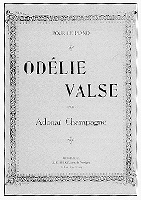 Odélie valse for piano, written prior to 1917. Montréal: J.-É. Bélair. Appeared in Le Passe-temps (Montreal), vol. XXII, no. 563, October 21, 1916, p. 413-415. Odélie valse for piano, written prior to 1917. Montréal: J.-É. Bélair. Appeared in Le Passe-temps (Montreal), vol. XXII, no. 563, October 21, 1916, p. 413-415.
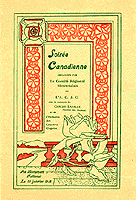 |
 Program including the premiere of Claude Champagne's J'ai du bon tabac.... January 31, 1918. Program including the premiere of Claude Champagne's J'ai du bon tabac.... January 31, 1918.
(1972-11/L1,1) |
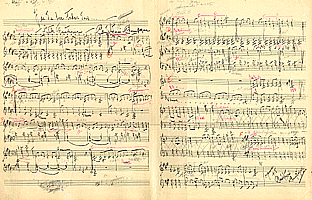 Reduced score of an orchestral arrangement of the folksong J'ai du bon tabac... Autograph manuscript, January 1, 1918. Reduced score of an orchestral arrangement of the folksong J'ai du bon tabac... Autograph manuscript, January 1, 1918.
(1972-11/D6,4)
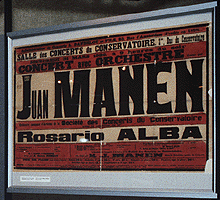 Poster for concert at which Claude Champagne's Hercule et Omphale was performed in Paris, in 1926. Poster for concert at which Claude Champagne's Hercule et Omphale was performed in Paris, in 1926.
"Hercule et Omphale is based on two ideas: virility and femininity. The dualism of these ideas is expressed by the music. The theme of Hercules stands for strength and the theme of Omphale symbolizes charm. Those two ideas struggle to the final triumph of charm over strength. This symphonic poem is basically a dialogue between the two themes."
Claude Champagne, "Hercule et Omphale," n.d.
(1972-11/C3,1).
 | Listen to an excerpt from Hercule et Omphale. |
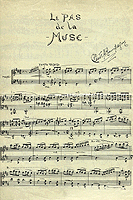 Le Pas de la muse for piano, possibly written before 1921. Le Pas de la muse for piano, possibly written before 1921.
Autograph manuscript on linen paper.
 Article by Robert de Roquebrune on Claude Champagne's Suite canadienne, in Paris-Canada, November 3, 1928. Article by Robert de Roquebrune on Claude Champagne's Suite canadienne, in Paris-Canada, November 3, 1928.
The Suite canadienne for choir and orchestra was written in
1927. The work is divided into four parts: "C'est Pinson avec Cendrouille," "Nous étions trois capitaines," "Et moi je m'en passe" and "Le fils du roi s'en va chassant."
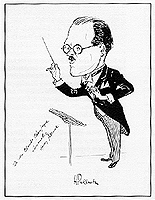 Caricature by Harry Pollack of Claude Champagne conducting the Montreal Orchestra performing his Suite canadienne for choir and orchestra. This concert took place at His Majesty's Theatre on March 5, 1933. Caricature by Harry Pollack of Claude Champagne conducting the Montreal Orchestra performing his Suite canadienne for choir and orchestra. This concert took place at His Majesty's Theatre on March 5, 1933.
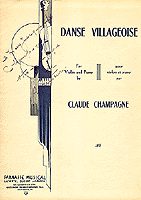 The first version of the Danse villageoise was written in 1929. It was published by Parnasse Musical in 1949. Claude Champagne dedicated this copy to his daughter, Jacqueline. The first version of the Danse villageoise was written in 1929. It was published by Parnasse Musical in 1949. Claude Champagne dedicated this copy to his daughter, Jacqueline.
Reproduced with permission from Berandol Music Limited.
 | Listen to an excerpt from Danse villageoise. |
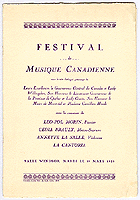 |
 Program of the concert including the premiere of the first version of the Danse villageoise (for violin and piano). Program of the concert including the premiere of the first version of the Danse villageoise (for violin and piano).
March 19, 1929. |
 Photographic half-length portrait of Claude Champagne at the age of thirty-eight. Photographic half-length portrait of Claude Champagne at the age of thirty-eight.
[1929], photographer: Albert Dumas.
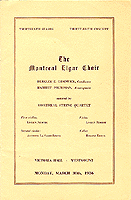 The Montreal String Quartet gave the first performance of the second version of the Danse villageoise. March 30, 1936. The Montreal String Quartet gave the first performance of the second version of the Danse villageoise. March 30, 1936.
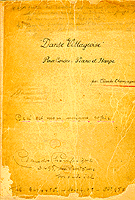 |
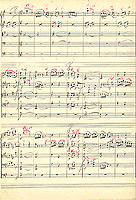 |
 Pages from the third version of the Danse villageoise (for strings, harp and piano). Autograph manuscript, n.d.
Pages from the third version of the Danse villageoise (for strings, harp and piano). Autograph manuscript, n.d. |
 | Listen to an excerpt from the string orchestra version of Danse villageoise. |
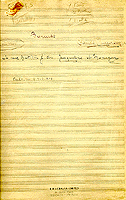 |
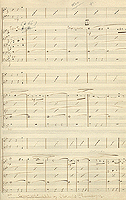 Berceuse for small orchestra written in 1932 and dedicated to Claude Champagne's two daughters. Berceuse for small orchestra written in 1932 and dedicated to Claude Champagne's two daughters. |
 Claude Champagne in his studio with his two daughters Monique (left) and Jacqueline. Claude Champagne in his studio with his two daughters Monique (left) and Jacqueline.
ca. 1932, photographer unknown.
Around 1933, Claude Champagne did the arrangements of a group of folk
songs (Isabel Went Walking, Fair Wind; À St-Malo beau port de mer; Lovely Frances, The Rosebush) especially for the Orphéon de Montréal choir, conducted by Arthur Laurendeau, choirmaster at St. James Cathedral.
 The Champagne family at Morgan Lake, Quebec. From left to right: Monique Champagne; Jacqueline Champagne; Fred Nichol, vice-president of I.B.M.; Claude Champagne; Jeanne Champagne (seated). The Champagne family at Morgan Lake, Quebec. From left to right: Monique Champagne; Jacqueline Champagne; Fred Nichol, vice-president of I.B.M.; Claude Champagne; Jeanne Champagne (seated).
[July 30, 1938], photographer unknown.
 Front Cover from the score of Quadrilha Brasileira published by BMI Canada Limited in 1951. Front Cover from the score of Quadrilha Brasileira published by BMI Canada Limited in 1951.
Reproduced with permission from Berandol Music Limited.
Quadrilha Brasileira was written in 1942 at the request of Jean Désy, Canadian ambassador to Brazil, in honour of Canada's Dominion Day. The Brazilian pianist Arnaldo Estrella first performed the work on July 1 of the same year in Rio de Janeiro. Photocopy of autograph manuscript. Annotations by the composer.
 | Listen to an excerpt from Quadrilha Brasileira. |




|